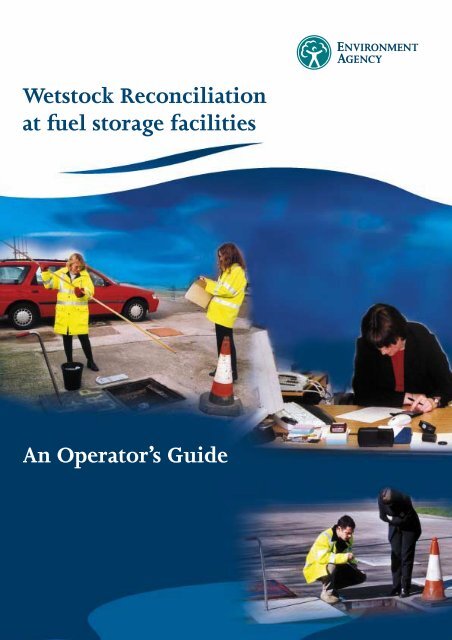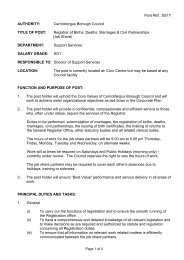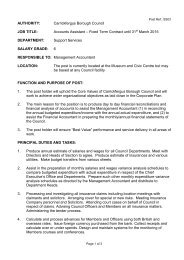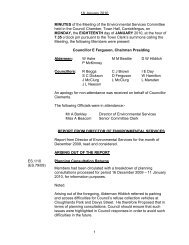Wetstock Reconciliation at fuel storage facilities - Carrickfergus ...
Wetstock Reconciliation at fuel storage facilities - Carrickfergus ...
Wetstock Reconciliation at fuel storage facilities - Carrickfergus ...
- No tags were found...
You also want an ePaper? Increase the reach of your titles
YUMPU automatically turns print PDFs into web optimized ePapers that Google loves.
<strong>Wetstock</strong> <strong>Reconcili<strong>at</strong>ion</strong><strong>at</strong> <strong>fuel</strong> <strong>storage</strong> <strong>facilities</strong>An Oper<strong>at</strong>or’s Guide
Scope of the Document:This document aims to help the oper<strong>at</strong>orsof Fuel Storage Facilities improve theirwetstock reconcili<strong>at</strong>ion on site. It will begiven to site oper<strong>at</strong>ors by EnvironmentAgency staff during site visits withsupporting guidance and advice. It ishoped th<strong>at</strong> the widespread use of thisdocument will improve the quality ofwetstock reconcili<strong>at</strong>ion n<strong>at</strong>ionally with thebenefit of protecting the environment.It will be used on retail sites, workplace<strong>storage</strong> sites, diesel only sites and siteswhere other chemicals are storedunderground.The document has been written as a‘self-help’ guide and should be implementedby management and staff on site. <strong>Wetstock</strong>reconcili<strong>at</strong>ion is a vital tool on every <strong>fuel</strong><strong>storage</strong> facility and can provide a robustand cheap method of detecting leaks. Itwill be especially useful on those siteswith no other leak detection method.On sites with existing leak detectionsystems, wetstock reconcili<strong>at</strong>ion providesan additional method of leak detection.The document intentionally concentr<strong>at</strong>eson wetstock reconcili<strong>at</strong>ion but this is onlyone aspect of wetstock management. Siteoper<strong>at</strong>ors must also ensure th<strong>at</strong> theyemploy good practice across other aspectsof site management including the otherareas of wetstock management.Inform<strong>at</strong>ion on many of these aspects canbe found in the APEA/IP Guidance(Reference 1) and the DEFRA Code ofPractice (Reference 2).You may also getadvice from trade associ<strong>at</strong>ions, PetroleumLicencing Officers or specialist commercialorganis<strong>at</strong>ions.It is recognised th<strong>at</strong> there may be changesin the legisl<strong>at</strong>ive controls of petroleum<strong>storage</strong> in the future. However, the basicprinciples outlined in this booklet willcontinue to be relevant.This public<strong>at</strong>ion is the R & D TechnicalReport P2-285/TREnvironment Agency Project manager forR & D Project P2-285 wasJoanna Bradley, Environment Officer,North West Region.ISBN 1 844 32040 5©Environment Agency, November 2002.Reserv<strong>at</strong>ion of Rights st<strong>at</strong>ementAll rights reserved. No parts of thisdocument may be reproduced, stored in aretrieval system, or transmitted, in anyform or by any means, electronic,mechanical, photocopying, recording orotherwise without the prior permission ofthe Environment Agency. This excludes thetear off sheet <strong>at</strong> the back of Appendix 2which may be removed and copied.Dissemin<strong>at</strong>ion St<strong>at</strong>usInternal: Released to regions.External: Restricted – one copy only perapplicant. Multiple copies only byagreement with the Project Manager.1
Contents1. Introduction 31a – Protection of the environment 31b –Compliance with your Petroleum Licence 32. Good practice for oper<strong>at</strong>ing <strong>fuel</strong> <strong>storage</strong> <strong>facilities</strong> 43. <strong>Wetstock</strong> reconcili<strong>at</strong>ion – The theory 54. The benefits of recording cumul<strong>at</strong>ive d<strong>at</strong>a 65. Causes of wetstock variance 85a – General 85b –Deliveries 95c – Sales 95d –Tank stock readings 106. Wh<strong>at</strong> is your normal oper<strong>at</strong>ing p<strong>at</strong>tern? 127. Wh<strong>at</strong> to do if you devi<strong>at</strong>e from your normal oper<strong>at</strong>ing p<strong>at</strong>tern 138. Advanced leak detection 149. Summary 1410.References 1411.Glossary of terms 15Appendix 1 16Appendix 2 18Published by:Environment AgencyRio HouseW<strong>at</strong>erside DriveAztec WestAlmondsburyBristol BS32 4UDTel:01454 624400Fax:01454 624409www.environment-agency.gov.ukwww.environment-agency.wales.gov.ukFurther copies of this booklet can beobtained from your local Agencyoffice. Contact details can be found <strong>at</strong>the back of this document.Authors:Jo Bradley(Environment Agency)Bob Conlin and Marieke Feast(Fairbanks Environmental Limited)David Scott(Principal Petroleum Officer,Lancashire County Council)Contributors:Associ<strong>at</strong>ion for Petroleum and ExplosivesAdministr<strong>at</strong>ion (APEA)BP Oil UK LtdChevron TexacoEcotech (UST) LtdGilbarco Veeder-RootGre<strong>at</strong>er Manchester County Fire ServiceInstitute of PetroleumLondon Fire BrigadeMercury Petroleum Systems LimitedMerseyside Fire BrigadeScottish Environment Protection AgencyShell UK Oil Products LtdTotalFinaElf UK LtdWest Yorkshire Fire Service2
3. <strong>Wetstock</strong> reconcili<strong>at</strong>ion –The theoryThis section details how to calcul<strong>at</strong>e your wetstock figures,and more importantly, how to get maximum benefit fromthem. Figure 1 is an example of a typical wetstock form.Blank forms are provided <strong>at</strong> the back of this booklet, inAppendix 2.DefinitionsClosing stock (E) = volume of <strong>fuel</strong> measuredin the tank <strong>at</strong> close of business.Opening stock (A) = closing stock from previous day.Book stock (D) = theoretical (calcul<strong>at</strong>ed) volume inthe tank <strong>at</strong> close of business.Variance (F) = closing stock minus book stock.Figure 1WETSTOCK RECONCILIATION FORMTANK: 3 CAPACITY: 27,200 PUMPS: 1,2,3,4 GRADE: UnleadedMONTH: JULY YEAR: 2002 DAILY CUMULATIVEOpening Book Closing VarianceD<strong>at</strong>e Day Stock Deliveries Sales Stock Stock Variance Loss (-ve) Sales %A B C D E F G H I(=A+B-C) (=E-D) (=G÷Hx100)Brought Forward From Previous Period1 MON 12838 0 1165 11673 11668 -5 -5 1165 -0.432 TUE 11668 0 927 10741 10737 -4 -9 2092 -0.433 WED 10737 0 977 9760 9754 -6 -15 3069 -0.494 THUR 9754 0 906 8848 8842 -6 -21 3975 -0.535 FRI 8842 0 1033 7809 7802 -7 -28 5008 -0.566 SAT 7802 7000 850 13952 13995 43 15 5858 0.26Book stock is calcul<strong>at</strong>ed as follows:Book Stock (D) = Opening Stock (A) + Deliveries (B) - Sales (C)Hence in this example on the 1st July book stock = 12838 + 0 - 1165= 11673Variance is calcul<strong>at</strong>ed as follows:Variance = Closing Stock - Book StockHence in this example on the 1st July variance = 11668 - 11673=-5Variance can be a gain as well as a loss.A gain can equally indic<strong>at</strong>e a problemin need of investig<strong>at</strong>ion.The three right hand columns of the table (shaded in yellow) are used to calcul<strong>at</strong>e the cumul<strong>at</strong>ive percentage variance of the tank.We recommend th<strong>at</strong> the cumul<strong>at</strong>ive percentage variance be recorded, as this gives a better indic<strong>at</strong>ion overall of a tank’s performance.The benefits of recording and monitoring changes in the cumul<strong>at</strong>ive percentage variance are discussed on the following pages.Cumul<strong>at</strong>ive percentage variance is calcul<strong>at</strong>ed from the cumul<strong>at</strong>ive variance and cumul<strong>at</strong>ive sales. The cumul<strong>at</strong>ive variance is calcul<strong>at</strong>edby adding the current day’s variance to the running total of variances.In this example the cumul<strong>at</strong>ive variance on the 4th of July= variance on 4th July + cumul<strong>at</strong>ive variance 3rd July= -6 + (-15)= -21Cumul<strong>at</strong>ive sales are calcul<strong>at</strong>ed in the same manner:Cumul<strong>at</strong>ive sales on 5th July= sales for 5th July + cumul<strong>at</strong>ive sales from 4th July= 1033 + 3975= 5008Once the cumul<strong>at</strong>ive variance and cumul<strong>at</strong>ive sales have been calcul<strong>at</strong>ed they are used to calcul<strong>at</strong>e the cumul<strong>at</strong>ive percentagevariance as follows:Cumul<strong>at</strong>ive percentage variance (I) = Cumul<strong>at</strong>ive variance (G) x 100Cumul<strong>at</strong>ive sales (H)Hence in this example on the 5th of July cumul<strong>at</strong>ive variance = -28 x 1005008= -0.56The next section illustr<strong>at</strong>es the benefits of recording and running a cumul<strong>at</strong>ive percentage variance figure, as opposed to justrecording the variance on a daily basis.© Environment Agency5
Figure 3Cumul<strong>at</strong>ive percentage variance plotted against d<strong>at</strong>eCumul<strong>at</strong>ive percentage variance01.0702.0703.0704.0705.0706.0707.0708.0709.0710.0711.0712.0713.0714.0715.0716.0717.0718.0719.0720.07D<strong>at</strong>eBy plotting the results on a graph like this it becomes easier to see any trends and it may allow leaks to be identified more quickly.To make the graph as useful as possible, you must do all you can on site to minimise the causes of variance described in Section 5 ofthis booklet.If your wetstock reconcili<strong>at</strong>ion proceduresare not good enough, this leak could goundetected for a long period of time,leading to a much larger release of <strong>fuel</strong>.This could result in serious pollution,very high clean up costs and theprosecution of the site oper<strong>at</strong>or.This example clearly shows the benefit ofrecording and monitoring cumul<strong>at</strong>ivepercentage variance.Appendix 1 shows an example of twomonths’ figures for one tank. You can seehow the d<strong>at</strong>a looks when it is kept over aperiod of time.Recording cumul<strong>at</strong>ive d<strong>at</strong>a gives a clearer indic<strong>at</strong>ion of any changes in wetstock d<strong>at</strong>a trends on site.© Environment Agency7
5. Causes of wetstock varianceThere are many factors th<strong>at</strong> can affect wetstockvariance. It is important th<strong>at</strong> you are able torecognise the different causes of variance andaccount for them in your d<strong>at</strong>a.The following tablesdetail the most common causes of high variance,how to recognise them, and wh<strong>at</strong> can be done toavoid them.5a. GeneralProblem Definition Effect on d<strong>at</strong>a SolutionUnsynchronised Fuel sales are not totalled <strong>at</strong> Loss on the day is approxim<strong>at</strong>ely Take closing stock reading <strong>at</strong> the sameday end routine the same time as the closing equal to the volume of <strong>fuel</strong> sold time as day end routine is run.tank stock is recorded.during day end which is counterbalanced the next day.Administr<strong>at</strong>ion D<strong>at</strong>a incorrectly entered in Large variances. Check d<strong>at</strong>a especially on delivery dayserrors wetstock records. or after pump tests.Temper<strong>at</strong>ure Fuel expands and contracts For motor spirits, with every 1°C Fuel, which is warmer on deliveryvari<strong>at</strong>ion with the vari<strong>at</strong>ion in increase in temper<strong>at</strong>ure there is than the ambient in-tank temper<strong>at</strong>ure,temper<strong>at</strong>ure. an approx. 0.11% increase in will shrink; likewise <strong>fuel</strong> which isvolume. Likewise with every 1°C cooler on delivery than the ambientdecrease in temper<strong>at</strong>ure there is in-tank temper<strong>at</strong>ure will expand.Youa 0.11% decrease in volume. must be aware of this effect on yourwetstock records.Evapor<strong>at</strong>ion Fuel is a vol<strong>at</strong>ile product which Evapor<strong>at</strong>ion results in increased Evapor<strong>at</strong>ion will be highest in summerevapor<strong>at</strong>es. losses. There is less evapor<strong>at</strong>ion months. The effects of evapor<strong>at</strong>ion arefrom diesel, which typically particularly marked on low sellingshows lower losses than motor grades such as SUL and LRP.Vapourspirit grades.saving devices are available whichcould help to reduce loss throughevapor<strong>at</strong>ion.The following factors introduce unavoidable wetstock variances and should be accountedfor where possible: temper<strong>at</strong>ure dependant expansion and contraction of <strong>fuel</strong> andevapor<strong>at</strong>ion of motor spirit.© Environment Agency81210
5b. DeliveriesProblem Definition Effect on d<strong>at</strong>a SolutionDelivery during Delivery is partially complete Large loss on the day delivery Either run the day end routine beforeday end routine when the day end is run. is recorded. This is balanced the delivery starts, delay the day endthe next day by an equivalent routine until the delivery has beengain, or vice versa, depending on completed, or use a tank dip readingwhich day the delivery is taken immedi<strong>at</strong>ely prior to deliveryrecorded.as the closing stock for the day.Delivery recorded A common problem on sites Large gain in tank which has Check paper work on delivery daysin wrong tank with two tanks of the same physically received delivery. and ensure th<strong>at</strong> deliveries aregrade, a delivery may be Equivalent loss in tank which accur<strong>at</strong>ely recorded in therecorded in the wrong tank. had the delivery recorded in the correct tank.paper work but has not physicallyreceived the delivery.Delivery recorded Delivery as recorded in paper When volume delivered is less Check delivery certific<strong>at</strong>e (LP81 oras wrong quantity work does not m<strong>at</strong>ch volume than volume recorded this will LP80) when recording deliverydelivered. show as a loss on delivery day. quantities in paper work. Do notWhen volume delivered is gre<strong>at</strong>er assume th<strong>at</strong> the volume orderedthan volume recorded this will has been delivered.show as a gain.Split pots Fuel from a single tanker Large wetstock variances occur Try to avoid splitting pots on delivery.delivery delivery pot (compartment) on the two tanks th<strong>at</strong> the delivery It introduces errors into the wetstockis split between two tanks. was split between. The sum d<strong>at</strong>a which can be difficult to(Reference 4). of these two variances will account for.approxim<strong>at</strong>ely balance.The following factors introduce unnecessary wetstock variances and should be avoided where possible:administr<strong>at</strong>ion errors, split pot deliveries, incorrect recording of pump tests and pump calibr<strong>at</strong>ion.5c. SalesProblem Definition Effect on d<strong>at</strong>a SolutionMissing sales Sales are not transferred Increase in losses on tank Compare sales as recorded throughcorrectly from pump to point concurrent with a reduction pump totalisers and through till on aof sale. in sales for the tank. regular basis.Pump calibr<strong>at</strong>ion Pump meters may be over or Over dispensing pumps increases Pump meter inaccuracy has aunder dispensing. the cumul<strong>at</strong>ive percentage loss significant effect on your d<strong>at</strong>a. In thefrom a site. Under dispensing event of a change in cumul<strong>at</strong>ivepumps decreases the losses from variance, check pumps for a change ina site. The legal tolerance on calibr<strong>at</strong>ion. Note any pump which isinspection ranges from +1% outside the legal tolerance must notto -0.5%.be used until it has been reset andapproved by Trading Standards.© Environment Agency9
5d. Tank stock readingsProblem Definition Effect on d<strong>at</strong>a SolutionShort dipstick Dipstick is not the correct Large wetstock variances recorded. Replace any short dipsticks.length for the tank.See 5d.i.Vapour recovery Vapour recovery cre<strong>at</strong>es Changes in tank pressure affect Fit a pressure relief valvewith dipsticks pressure differences in the tank. tank stock readings. (dump valve) where possible.or unbalanced This has an adverse effect on See 5d.ii.hydrost<strong>at</strong>ic gauges tank stock readings.Tank gauge Gauge is inaccur<strong>at</strong>ely Inaccur<strong>at</strong>e gauge readings. Arrange for gauge recalibr<strong>at</strong>ion and, incalibr<strong>at</strong>ion calibr<strong>at</strong>ed for the tank. the meantime, account for stock level intank when interrog<strong>at</strong>ing wetstock d<strong>at</strong>a.5d.i – Short Dipstick300l200lEach dipstick is specific to thedimensions of an individual tank soit is important to check th<strong>at</strong> it is thecorrect one for the tank and th<strong>at</strong> thereare no signs of wear on the dipstick.Each division on a dipstick representsa volume of <strong>fuel</strong>, so the divisions <strong>at</strong>the middle of the tank are smallerthan those <strong>at</strong> the top and bottom ofthe tank. All tanks monitored with adipstick must have a protective pl<strong>at</strong>eabove the base of the tank to preventdamage to the tank.Figure 4Dipstick inmiddle of tank8400l8300l8200l8100l8000l7900l7800l100lDipstick <strong>at</strong> bottomof tankA worked exampleIf the bottom 5cm is missing from a dipstick the stick will sit 5cm lower in the tank.At the bottom of the tank 5cm is equivalent to 1 division on the dipstick, which represents 1unit of volume (in this example 1 division = 100 litres). Therefore this short dipstickwould measure 600 litres of <strong>fuel</strong> when there are only 500 litres in the tank.At the middle of the dipstick 5cm is equivalent to 5 divisions because the tank is wider,and this means th<strong>at</strong> in the middle of the tank the dipstick will measure 5 units more <strong>fuel</strong>than are present. In this example this means th<strong>at</strong> the dipstick measures 500 litres more <strong>fuel</strong>in the tank than is actually present.Clearly this cre<strong>at</strong>es a problem for wetstock records, as the amount of <strong>fuel</strong> in the tank willbe overestim<strong>at</strong>ed by varying amounts depending on the volume in the tank. In turn thiswill make it harder to identify any problems.7700l7600l7500l7400l7300l7200l7100l7000l6900l© Environment Agency10
5d. ii – Potential effects of Vapour Recovery Systems on wetstock reconcili<strong>at</strong>ionVapour recovery systems introduce pressure differences inside your tanks. The increased, or decreased, pressures can have adverse effectson tank measurements. Hydrost<strong>at</strong>ic gauges are pressure based measurement systems and therefore have problems accounting for theeffects of vapour recovery systems. It is possible to get hydrost<strong>at</strong>ic gauges balanced to work in tanks with vapour recovery systems.The effects of vapour recovery on tanks with dipsticks are illustr<strong>at</strong>ed below.Figure 5 Figure 6After delivery, pressure builds up in the tank. The compressedvapour in the tank forces the <strong>fuel</strong> to rise up the fill pipe, as thisis the point of least resistance. Any gauge or dipstick loc<strong>at</strong>ed inthe fill pipe will over-estim<strong>at</strong>e the amount of <strong>fuel</strong> in the tank.As <strong>fuel</strong> is sold from the tank, the pressure drops and a partialvacuum can be cre<strong>at</strong>ed. As a result, the <strong>fuel</strong> level drops in the fillpipe as shown. Any gauge or dipstick loc<strong>at</strong>ed in the fill pipe willtherefore under-estim<strong>at</strong>e the amount of <strong>fuel</strong> in the tank.This also applies for dipsticks loc<strong>at</strong>ed in diptubes.There is a potential overfill danger whentank contents are under-estim<strong>at</strong>ed.1 Use the correct dipstick for the tank and check th<strong>at</strong> it is the correct length.2 Incorrect tank calibr<strong>at</strong>ions can have a significant effect on wetstock variance.3 Vapour recovery can affect stock readings where unbalanced hydrost<strong>at</strong>ic gauges or dipsticks are in use.© Environment Agency11
6. Wh<strong>at</strong> is your normal oper<strong>at</strong>ing p<strong>at</strong>tern?In order to fully interpret your wetstock figures, we recommend th<strong>at</strong> you determine wh<strong>at</strong> the normal oper<strong>at</strong>ing p<strong>at</strong>tern is for each tankon your site. For example, on a daily basis, you may always show a large gain after delivery followed by a series of small losses until thenext delivery on one tank. Or you may show a large loss on delivery followed by a series of small gains on the next tank.In addition to the day to day oper<strong>at</strong>ing p<strong>at</strong>tern wetstock d<strong>at</strong>a will have a seasonal trend which generally shows an increase in lossesduring the warmer summer months. These seasonal trends are more pronounced for low selling grades. Figure 7 shows the annualprofile of a single site using monthly totals and Figure 8 shows a cumul<strong>at</strong>ive percentage figure. Appendix 1 shows you how to calcul<strong>at</strong>emonthly totals.Figure 7A typical oper<strong>at</strong>ing p<strong>at</strong>tern – Monthly percentage variancePeriod loss/gain (%)g ( )Jan Feb Mar Apr May Jun Jul Aug Sep Oct Nov DecD<strong>at</strong>eLow Sulphur Diesel LRP UnleadedFigure 8A typical oper<strong>at</strong>ing p<strong>at</strong>tern – Cumul<strong>at</strong>ive percentage variance year to d<strong>at</strong>eCumul<strong>at</strong>ive loss/gain (%)01-Jan 01-Feb 01-Mar 01-Apr 01-May 01-Jun 01-Jul 01-Aug 01-Sep 01-Oct 01-Nov 01-DecNotice how the lead replacement petrol (LRP) has a lower overall percentage variance and is more err<strong>at</strong>ic than the higher sellinggrades. This is because any wetstock variances on a low selling grade will be accentu<strong>at</strong>ed. For example a 5 litre loss on a tank selling1000 litres per day is a 0.5% loss, whereas on a tank selling 100 litres a day a 5 litre loss is a 5% loss.D<strong>at</strong>eOnce you have determined the normal oper<strong>at</strong>ing p<strong>at</strong>tern for your tanks, taking into account any seasonal vari<strong>at</strong>ion, you can quickly seeif a tank devi<strong>at</strong>es from it’s normal oper<strong>at</strong>ing p<strong>at</strong>tern. If a devi<strong>at</strong>ion is noticed, you should investig<strong>at</strong>e the cause immedi<strong>at</strong>ely. Staff on sitemust be trained so they know wh<strong>at</strong> to do if a devi<strong>at</strong>ion from the oper<strong>at</strong>ing p<strong>at</strong>tern is noticed. Records of staff training must be kept onthe site register.1 Determine the normal oper<strong>at</strong>ing p<strong>at</strong>tern for each tank on your site.2 Have a plan in place which identifies wh<strong>at</strong> to do if you devi<strong>at</strong>e from your normal oper<strong>at</strong>ing p<strong>at</strong>tern.© Environment Agency12 16
7. Wh<strong>at</strong> to do if you devi<strong>at</strong>e from your normal oper<strong>at</strong>ing p<strong>at</strong>ternIf you are concerned about your wetstock d<strong>at</strong>a, but you are sure th<strong>at</strong> you have accounted for all of the above factors, there remain twosignificant possibilities – the <strong>fuel</strong> may have been stolen or you may have a leak.If you think th<strong>at</strong> you have a leak, you must inform your Petroleum Licensing Officer (PLO) as th<strong>at</strong> is a condition of your licence. Next,all necessary action should be taken to minimise the health and safety risk.You should also inform the Environment Agency as they willidentify any action necessary to protect the environment.Your site should have a written procedure explaining wh<strong>at</strong> to do in the event of a suspected leak. This is sometimes called an Escal<strong>at</strong>ionProcedure. A copy of the procedure should be kept in your site register. It should contain details of wh<strong>at</strong> action you should take, andhow to carry them out. It should also contain details of how to:1. investig<strong>at</strong>e the cause of the loss;2. contact the PLO and Environment Agency;3. take any necessary health and safety actions;4. prevent any further leakage;5. quantify the volume of product lost;6. identify any leaking tank or line;7. repair the leak or decommission theequipment in agreement with your PLO;8. remedi<strong>at</strong>e any pollution caused inagreement with the Agency..It is vital th<strong>at</strong> you tell the PLO and Agency as quickly as possible. They can provide advice on wh<strong>at</strong> to do in order to minimise the risksto health and safety and the environment.The Agency has access to emergency equipment to control and contain pollution, and has inform<strong>at</strong>ion about the local environment.Any delay in calling may lead to serious environmental pollution or a danger to public safety.Draw up an escal<strong>at</strong>ion procedure for your site and make sure all staff are aware of it.© Environment Agency13
8. Advanced leak detectionThese guidance notes should help increase the likelihood of earlier leak detection. However, small gradual leaks, which are very difficultto identify by visual inspection of your daily records may still be present on your site.St<strong>at</strong>istical inventory reconcili<strong>at</strong>ion is becoming more widely accepted as a means of detecting these smaller leaks <strong>at</strong> a much earlier stage,thus preventing wh<strong>at</strong> would otherwise become significant pollution incidents. It involves using your daily reconcili<strong>at</strong>ion d<strong>at</strong>a toestablish a st<strong>at</strong>istical variance (loss or gain) trend for each of your tanks which takes into account all the cause factors explained earlier.When an unacceptable variance occurs it is highlighted. The cause of this unacceptable variance should then be investig<strong>at</strong>ed.St<strong>at</strong>istical inventory reconcili<strong>at</strong>ion can be carried out on site and there are systems available th<strong>at</strong> calcul<strong>at</strong>e your wetstock figures on adaily and cumul<strong>at</strong>ive basis. This d<strong>at</strong>a could be further analysed with st<strong>at</strong>istical software packages in order to carry out a more detailedanalysis of d<strong>at</strong>a. It is also possible to employ a third party to carry out st<strong>at</strong>istical analysis of your d<strong>at</strong>a.It is worth remembering th<strong>at</strong> even with this method the d<strong>at</strong>a you provide still needs to be sufficiently accur<strong>at</strong>e and reliable.You mustalso remember th<strong>at</strong> even if you employ a third party the responsibility for the maintenance of your wetstock records remains with thepetroleum licence holder. It is also still vital th<strong>at</strong> you maintain a mechanism for alerting the PLO and Environment Agency in the eventof a suspected leak or spillage.On sites where the surrounding environment is particularly sensitive, or sites with a large throughput, more sensitive leak detectionsystems may be required to provide the required level of protection. Guidance can be sought on the various systems available from your<strong>fuel</strong> suppliers, commercial organis<strong>at</strong>ions specialising in wetstock reconcili<strong>at</strong>ion or your Trade Associ<strong>at</strong>ion.9. SummaryBy using this booklet you can reduce the risk of your site having any harmful effects on the local community and environment.If you work through the wetstock calcul<strong>at</strong>ions and introduce the use of cumul<strong>at</strong>ive percentage variance onto your site, you couldimprove the quality of your wetstock reconcili<strong>at</strong>ion. This may then enable you to effectively and efficiently detect possible leaks or otherwetstock rel<strong>at</strong>ed problems on site.10. References1. Guidance for the design, construction, modific<strong>at</strong>ion and maintenance of petrol filling st<strong>at</strong>ions, 1999,ISBN 0 85293 217 0: Associ<strong>at</strong>ion for Petroleum and Explosives Administr<strong>at</strong>ion/Institute of Petroleum2. Groundw<strong>at</strong>er Protection code for petrol st<strong>at</strong>ions and other <strong>fuel</strong> dispensing <strong>facilities</strong> involving underground <strong>storage</strong> tanks,2001: Department for Environment, Food and Rural Affairs DEFRA Public<strong>at</strong>ion Number PB6750A3. Dispensing petrol – Assessing and controlling the risks of fire and explosion <strong>at</strong> sites where petrol is stored and dispensed as a <strong>fuel</strong>,HS(G) 146, 1996, ISBN 0 7176 1048 9: Health and Safety Executive4. Offloading procedures for split compartment deliveries of petrol between service st<strong>at</strong>ion tanks, 2001, ISBN 0 85293 353 3:The Institute of Petroleum© Environment Agency14
11. Glossary of termsAquifer – a permeable rock th<strong>at</strong> stores groundw<strong>at</strong>er and allows it to flow readily into a well or borehole.Calibr<strong>at</strong>ion – correl<strong>at</strong>ion of the readings of an instrument with a standard.Cumul<strong>at</strong>ive – increasing in amount by successive additions.Groundw<strong>at</strong>er – the w<strong>at</strong>er in the ground below the w<strong>at</strong>er table.LRP – Lead Replacement Petrol.Pollute – to contamin<strong>at</strong>e or defile the environment.Risk assessment – a process of identifying hazards, assessing the likelihood of them happening and estim<strong>at</strong>ing the possibleconsequences. The assessment will then go on to identify the ways of removing the hazard or minimising the consequences.St<strong>at</strong>istical inventory reconcili<strong>at</strong>ion – the use of a st<strong>at</strong>istical method to monitor the movement of <strong>fuel</strong> around the site and to identifyany discrepancies.Totalisers – a device on a <strong>fuel</strong> dispenser showing the total number of litres of passing through th<strong>at</strong> dispenser.Variance – the difference between the measured volume of <strong>fuel</strong> and the volume of <strong>fuel</strong> estim<strong>at</strong>ed by book-keeping.Vapour recovery system – the pipework and associ<strong>at</strong>ed equipment used to connect vapour emission sources and feed them to a centralcollection point for recovery.Vol<strong>at</strong>ile – evapor<strong>at</strong>es rapidly.<strong>Wetstock</strong> reconcili<strong>at</strong>ion – m<strong>at</strong>hem<strong>at</strong>ical calcul<strong>at</strong>ions to compare the measured volume of <strong>fuel</strong> with the volume of <strong>fuel</strong> estim<strong>at</strong>ed bybook-keeping and to identify any discrepancy between the two volumes.© Environment Agency15
Appendix 1The table below illustr<strong>at</strong>es how to record wetstock d<strong>at</strong>a, monthly performance (totals and cumul<strong>at</strong>ive percentage variance) and arunning cumul<strong>at</strong>ive percentage variance.Your cumul<strong>at</strong>ive d<strong>at</strong>a can be carried forward from month to month using the three right handcolumns.Site Name:WETSTOCK RECONCILIATION FORMTANK: 1 CAPACITY: 30000 litres PUMPS: 1,2 GRADE: unleadedMONTH: March YEAR: 2002 DAILY CUMULATIVEOpening Book Closing VarianceD<strong>at</strong>e Day Stock Deliveries Sales Stock Stock Variance Loss (-ve) Sales %A B C D E F G H I(=A+B-C) (=E-D) (=G÷Hx100)Brought Forward From Previous Period1 Fri 8846 20200 8861 20185 20250 65 65 8861 0.732 S<strong>at</strong> 20250 0 9114 11136 11095 -41 24 17975 0.133 Sun 11095 25200 9023 27272 27261 -11 13 26998 0.054 MON 27261 0 9127 18134 18139 5 18 36125 0.055 Tues 18139 0 9060 9079 9018 -61 -43 45185 -0.106 Wed 9018 0 7352 1666 1666 0 -43 52537 -0.087 Thurs 1666 27200 7972 20894 20904 10 -33 60509 -0.058 Fri 20904 0 8572 12332 12298 -34 -67 69081 -0.109 S<strong>at</strong> 12298 20200 8617 23881 23881 0 -67 77698 -0.0910 suN 23881 0 8613 15268 15241 -27 -94 86311 -0.1111 mon 15241 22200 8361 29080 29078 -2 -96 94672 -0.1012 Tues 29078 0 8030 21048 21024 -24 -120 102702 -0.1213 Wed 21024 0 7864 13160 13126 -34 -154 110566 -0.1414 Thurs 13126 0 9682 3444 3395 -49 -203 120248 -0.1715 Fri 3395 22200 8853 16742 16804 62 -141 129101 -0.1116 S<strong>at</strong> 16804 0 9802 7002 6944 -58 -199 138903 -0.1417 Sun 6944 24200 7622 23522 23516 -6 -205 146525 -0.1418 MON 23516 0 7939 15577 15542 -35 -240 154464 -0.1619 Tues 15542 0 9090 6452 6387 -65 -305 163554 -0.1920 Wed 6387 24200 7571 23016 23090 74 -231 171125 -0.1321 Thurs 23090 0 6737 16353 16329 -24 -255 177862 -0.1422 Fri 16329 21200 9034 28495 28507 12 -243 186896 -0.1323 S<strong>at</strong> 28507 0 8304 20203 20191 -12 -255 195200 -0.1324 Sun 20191 15200 8931 26460 26454 -6 -261 204131 -0.1325 MON 26454 0 8944 17510 17468 -42 -303 213075 -0.1426 Tues 17468 0 8121 9347 9288 -59 -362 221196 -0.1627 Wed 9288 0 7574 1714 1689 -25 -387 228770 -0.1728 Thurs 1689 25200 8387 18502 18507 5 -382 237157 -0.1629 Fri 18507 0 9242 9265 9211 -54 -436 246399 -0.1830 S<strong>at</strong> 9211 22200 9240 22171 22196 25 -411 255639 -0.1631 Sun 22196 0 9464 12732 12701 -31 -442 265103 -0.17Total 22196 269400 265103 12732 12701 -442 -442 265103 -0.1716
Site Name:WETSTOCK RECONCILIATION FORMTANK: 1 CAPACITY: 30000 litres PUMPS: 1,2 GRADE: unleadedMONTH: April YEAR: 2002 DAILY CUMULATIVEOpening Book Closing VarianceD<strong>at</strong>e Day Stock Deliveries Sales Stock Stock Variance Loss (-ve) Sales %A B C D E F G H I(=A+B-C) (=E-D) (=G÷Hx100)Brought Forward From Previous Period -442 265103 -0.171 Mon 12701 24200 8245 28656 28672 16 -426 273348 -0.162 Tues 28672 0 7525 21147 21109 -38 -464 280873 -0.173 Wed 21109 0 8754 12355 12307 -48 -512 289627 -0.184 Thurs 12307 0 9813 2494 2448 -46 -558 299440 -0.195 Fri 2448 24200 8751 17897 17900 3 -555 308191 -0.186 S<strong>at</strong> 17900 0 9252 8648 8595 -53 -608 317443 -0.197 Sun 8595 22200 7962 22833 22863 30 -578 325405 -0.188 Mon 22863 0 7880 14983 14953 -30 -608 333285 -0.189 Tues 14953 24200 6967 32186 32108 -78 -686 340252 -0.2010 Wed 32108 0 8503 23605 23584 -21 -707 348755 -0.2011 Thurs 23584 0 8468 15116 15069 -47 -754 357223 -0.2112 Fri 15069 22200 8792 28477 28468 -9 -763 366015 -0.2113 S<strong>at</strong> 28468 0 9490 18978 18963 -15 -778 375505 -0.2114 Sun 18963 0 8296 10667 10612 -55 -833 383801 -0.2215 Mon 10612 24200 6731 28081 28089 8 -825 390532 -0.2116 Tues 28089 0 6771 21318 21297 -21 -846 397303 -0.2117 Wed 21297 0 9300 11997 11946 -51 -897 406603 -0.2218 Thurs 11946 22200 8979 25167 25189 22 -875 415582 -0.2119 Fri 25189 0 7292 17897 17872 -25 -900 422874 -0.2120 S<strong>at</strong> 17872 0 8188 9684 9613 -71 -971 431062 -0.2321 Sun 9613 0 7968 1645 1644 -1 -972 439030 -0.2222 Mon 1644 24200 8182 17662 17698 36 -936 447212 -0.2123 Tues 17698 0 7911 9787 9734 -53 -989 455123 -0.2224 Wed 9734 24200 7941 25993 25993 0 -989 463064 -0.2125 Thurs 25993 0 8105 17888 17837 -51 -1040 471169 -0.2226 Fri 17837 15200 7993 25044 25016 -28 -1068 479162 -0.2227 S<strong>at</strong> 25016 0 10182 14834 14777 -57 -1125 489344 -0.2328 Sun 14777 0 8536 6241 6183 -58 -1183 497880 -0.2429 Mon 6183 24200 8649 21734 21758 24 -1159 506529 -0.2330 Tues 21758 0 7938 13820 13793 -27 -1186 514467 -0.2331Total 21758 251200 249364 13820 13793 -744 -1186 514467 -0.2317
Appendix 2WETSTOCK RECONCILIATION FORMTANK: CAPACITY: PUMPS: GRADE:MONTH: YEAR: DAILY CUMULATIVEOpening Book Closing VarianceD<strong>at</strong>e Day Stock Deliveries Sales Stock Stock Variance Loss (-ve) Sales %A B C D E F G H I(=A+B-C) (=E-D) (=G÷Hx100)Brought Forward From Previous Period12345678910111213141516171819202122232425262728293031Total18
Would you like to find out more aboutus, or about your environment?Then call us on08708 506 506 (Mon-Fri 8-6)emailenquiries@environment-agency.gov.ukor visit our websitewww.environment-agency.gov.ukincident hotline 0800 80 70 60 (24hrs)floodline 0845 988 1188NW-12/02-5K-Ci-BGUY
















